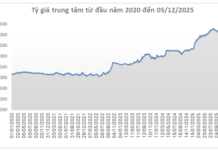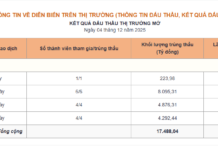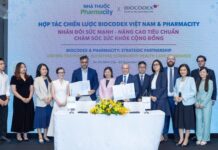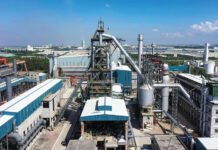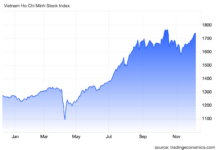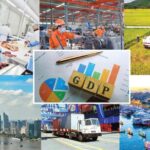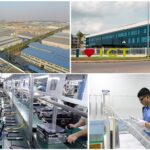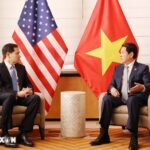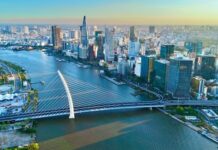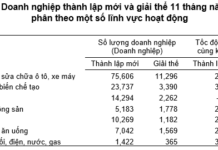From Assembly to Ownership: Vietnam’s Industrial Evolution
“25 years ago, when many partners requested components we didn’t have, but today I’m proud to say we can supply them with competitive pricing and assured quality,” shared Mrs. Trần Thị Thu Trang, Chairwoman of Hanel PT’s Board of Directors.
Mrs. Trang’s story reflects the maturation of Vietnamese enterprises within the industrialization process. However, she highlights the biggest challenge for Vietnam in the coming decade: transitioning “from assembly to manufacturing, from being subcontractors to technology owners.”
Currently, the manufacturing sector accounts for approximately 25% of GDP, yet it remains heavily focused on assembly with low domestic value. Electronics, making up 33% of the nation’s total export turnover, are predominantly handled by foreign-invested enterprises (FIEs). According to the General Statistics Office (Ministry of Finance), from 2016 to 2024, exports of electronics, computers, and components surged from $18.5 billion to $68 billion, while imports rose from $27.8 billion to over $100 billion. Despite rapid expansion, domestic value remains modest.
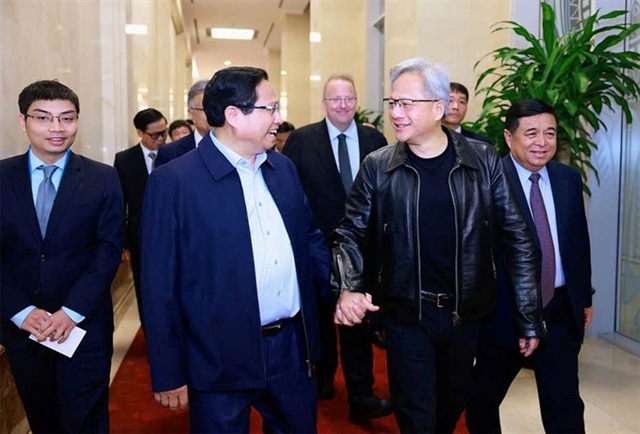
Prime Minister Phạm Minh Chính welcomes NVIDIA’s Chairman and senior leaders on their second visit to Vietnam. Photo: VGP/Nhật Bắc |
Amid the Fourth Industrial Revolution, driven by core technologies like artificial intelligence (AI), big data, cloud computing, robotics, and semiconductors, competitive advantages among economies are being redefined. As a nation accelerating industrialization, Vietnam has a unique opportunity to close the gap if it seizes this moment effectively.
According to Mrs. Nguyễn Thị Phương Thảo, Chairwoman of Sovico Group, the world is entering an era of “AI-driven transformation” across all sectors. “Vietnam has a golden opportunity to deeply integrate into the global value chain, particularly in semiconductors and AI. Vietnam’s moment has arrived—if we dare to think big, act boldly, and move swiftly,” Mrs. Thảo stated.
“We’re living in an era where AI, semiconductors, data, and the digital economy are evolving daily. These technologies not only shape how we produce but also transform how we live, learn, and grow,” she observed.
Mrs. Thảo noted that Vietnam ranks among the top 6 globally in AI openness and boasts a thriving innovation ecosystem spanning fintech, smart manufacturing, and clean energy.
In semiconductors, the global supply chain shift offers Vietnam a unique advantage: a secure, dynamic, and attractive environment.
“For the first time, we have the chance to engage more deeply in the value chains of the world’s leading tech corporations,” Mrs. Thảo emphasized.
Government Initiatives Driving Progress
In recent years, the Party, National Assembly, and Government have introduced landmark policies to propel Vietnam’s industrial development toward depth, shifting from “assembly” to “manufacturing” and “innovation.”
Key initiatives include Resolution 57-NQ/TW on science, technology, innovation, and national digital transformation; Resolution 68-NQ/TW on developing the private sector as a key economic driver; and Resolutions 193 and 198 on high-tech industrial development.
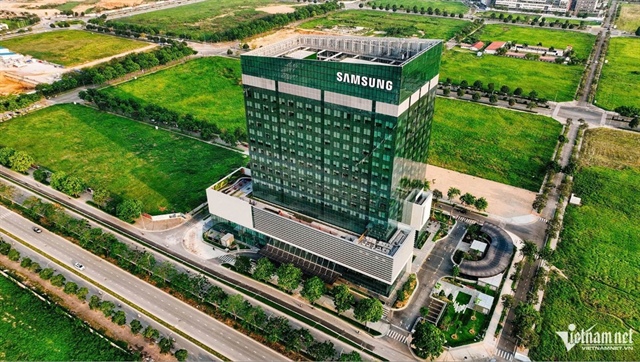
Samsung’s largest R&D center in Southeast Asia, located on a 1.2-hectare site near Hòa Bình Park. |
Building on these, the Government issued Resolution 03/NQ-CP—an action plan for Resolution 57—directing ministries, sectors, and localities to remove institutional barriers and introduce special mechanisms for investment and public procurement of new technologies. The Government also promotes innovation hubs and strategic sectors like semiconductors, AI, digital technology, and smart cities.
By 2030, Vietnam aims to establish at least 5 national flagship programs in these areas, laying the foundation for sustainable high-tech industrial growth.
Semiconductors exemplify this progress. Vietnam now has over 50 chip design firms with 7,000 engineers and 15 companies involved in chip packaging and testing, employing over 10,000 technicians. Viettel is set to inaugurate its first chip manufacturing plant, marking Vietnam’s entry into the global chip production map.
Notably, tech giants like Nvidia, Qualcomm, Apple, Samsung, and Amkor have chosen Vietnam for manufacturing or R&D centers. Nvidia and Qualcomm’s selection of Vietnam as a strategic hub for AI and semiconductor research underscores Vietnam’s rising global value chain position.
Additionally, Vietnam has enacted the Digital Technology Industry Law and is drafting the Key Industrial Law, alongside tax, land, infrastructure, and workforce incentives to attract high-tech FDI. The Government also encourages FIEs to establish R&D centers in Vietnam.
Looking ahead, the Ministry of Industry and Trade notes that Vietnam’s key export industries—phones, computers, machinery—are primarily FDI-driven. Large Vietnamese enterprises remain scarce, facing technical standards and trade promotion barriers. Supporting firms to meet international standards is crucial for “Made by Vietnam” products to enter demanding markets like the US and EU.
The Ministry advocates accelerating advanced technology transfer through mechanisms connecting Vietnamese firms with international partners, legal consulting, and financial support from the National Technology Innovation Fund or science-technology ODA. This enables enterprises to access modern production lines, equipment, and know-how at lower costs, accelerating industrialization and competitiveness.
According to the Ministry, smart manufacturing offers a “shortcut to modernization,” enabling Vietnam to achieve advanced industrial status much faster than earlier industrializers.
While pioneers like the UK took centuries, Japan reduced this to 50 years, and East Asian NICs like South Korea to under 30 years. The smart industrial revolution provides Vietnam and other developing nations a chance to compress their industrialization timelines.
FPT Chairman Trương Gia Bình stressed, “A nation cannot prosper by merely subcontracting and relying on foreign technology. We must own our technology, innovate, and create our unique value.”
The journey from “assembly” to “ownership” is challenging, but Vietnam has the strategic vision, policy foundation, and political resolve to advance steadily.
Government efforts in institutional reform, investment climate improvement, tech workforce development, high-quality FDI attraction, and innovation support have opened a new chapter for Vietnamese industry.
From being the world’s “subcontractor,” Vietnam is nearing its goal of “owning” the global value chain, progressively realizing its ambition to become a modern, high-income industrialized nation by 2045.
Ánh Dương
– 09:12 13/10/2025
Vietnam’s Remarkable Growth Captivates Global Investors
The financial analysis platform ainvest.com (USA) published an article on October 5th, praising Vietnam’s robust economic growth. The report highlights that Vietnam’s GDP for Q3 2025 is estimated to surge by 8.23%, despite challenges posed by U.S. tariff policies and adverse weather conditions.
U.S. Secretary of State: President Trump Prioritizes Vietnam as a Key Regional Partner
As part of his attendance at the 80th United Nations General Assembly’s High-Level General Debate and bilateral engagements in the United States, President Lương Cường met with U.S. Secretary of State Marco Rubio on September 24th.






